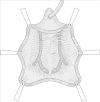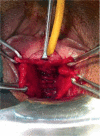Early results of a novel technique for anterior vaginal wall prolapse repair: anterior vaginal wall darn
- PMID: 24973955
- PMCID: PMC4105512
- DOI: 10.1186/1471-2490-14-51
Early results of a novel technique for anterior vaginal wall prolapse repair: anterior vaginal wall darn
Abstract
Background: The aim of this study was to describe the results of a 1-year patient follow-up after anterior vaginal wall darn, a novel technique for the repair of anterior vaginal wall prolapse.
Methods: Fifty-five patients with anterior vaginal wall prolapse underwent anterior vaginal wall darn. The anterior vaginal wall was detached using sharp and blunt dissection via an incision beginning 1 cm proximal to the external meatus and extending to the vaginal apex. The space between the tissues that attach the lateral vaginal walls to the arcus tendineus fasciae pelvis was then darned. Cough Stress Test, Pelvic Organ Prolapse Quantification, seven-item Incontinence Impact Questionnaire, and six-item Urogenital Distress Inventory scores were performed 1-year postoperatively to evaluate recovery.
Results: One-year postoperatively, all patients were satisfied with the results of the procedure. No patient had vaginal mucosal erosion or any other complication.
Conclusions: One-year postoperative findings for patients in this series indicate that patients with stage II-III anterior vaginal wall prolapse were successfully treated with the anterior vaginal wall darn technique.
Figures



Similar articles
-
A novel technique for anterior vaginal wall prolapse repair: anterior vaginal wall darn.ScientificWorldJournal. 2013;2013:198542. doi: 10.1155/2013/198542. Epub 2013 Feb 12. ScientificWorldJournal. 2013. PMID: 23476121 Free PMC article.
-
Anterior-apical single-incision mesh surgery (SIMS): surgical and functional outcomes at 1 year.J Minim Invasive Gynecol. 2015 Jan;22(1):50-6. doi: 10.1016/j.jmig.2014.07.002. Epub 2014 Jul 10. J Minim Invasive Gynecol. 2015. PMID: 25017520
-
Laparoscopic Pectopexy with Burch Colposuspension for Pelvic Prolapse Associated with Stress Urinary Incontinence.J Minim Invasive Gynecol. 2020 Jul-Aug;27(5):1023-1024. doi: 10.1016/j.jmig.2019.10.022. Epub 2019 Nov 1. J Minim Invasive Gynecol. 2020. PMID: 31683027
-
Diagnosis and management of complications following pelvic organ prolapse surgery using a synthetic mesh: French national guidelines for clinical practice.Eur J Obstet Gynecol Reprod Biol. 2024 Mar;294:170-179. doi: 10.1016/j.ejogrb.2024.01.015. Epub 2024 Jan 17. Eur J Obstet Gynecol Reprod Biol. 2024. PMID: 38280271 Review.
-
Surgery for Anterior Compartment Vaginal Prolapse: Suture-Based Repair.Urol Clin North Am. 2019 Feb;46(1):61-70. doi: 10.1016/j.ucl.2018.08.008. Urol Clin North Am. 2019. PMID: 30466703 Review.
Cited by
-
The Comparison of Outcomes of Transvaginal Mesh Surgery with and without Midline Fascial Plication for the Treatment of Anterior Vaginal Prolapse: A Randomized Controlled Trial.J Clin Med. 2021 Apr 27;10(9):1888. doi: 10.3390/jcm10091888. J Clin Med. 2021. PMID: 33925536 Free PMC article.
References
-
- Kenton K, Mueller ER. The global burden of female pelvic floor disorders. BJU Int. 2006;98:1–5. - PubMed
-
- Melville JL, Fan M, Rau H, Nygaard IE, Katon WJ. Major depression and urinary incontinence in women: temporal associations in an epidemiologic sample. Am J Obstet Gynecol. 2009;201(490):e1–e7. - PubMed
MeSH terms
LinkOut - more resources
Full Text Sources
Other Literature Sources
Medical
Miscellaneous

